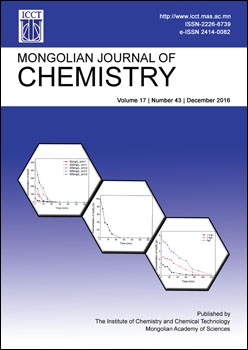Investigation of dissolved N<sub>2</sub>O production processes during wastewater treatment system in Ulaanbaatar
DOI:
https://doi.org/10.5564/mjc.v17i43.742Keywords:
Nitrous oxide, Wastewater, Stable isotope, NO2- reduction, NH2OH oxidation,Abstract
Nitrous oxide (N2O) is an increasing greenhouse gas in the troposphere and a potential destroyer of stratospheric ozone layer. Wastewater treatment plant (WWTP) is one of the anthropogenic N2O sources because inorganic and organic nitrogen compounds are converted to nitrate (NO3-, in the case of standard system) or N2 (in the case of advanced system) by bacterial nitrification and denitrifcation processes in WWTP. These major processes can be distinguished by isotopocule analysis. In order to reveal production mechanisms of N2O in a standard wastewater treatment, we made water sampling at the central WWTP in Ulaanbaatar. The water samples collected from seven stations including biological reaction tanks were measured for concentration and isotopocule ratios of dissolved N2O and other inorganic nitrogen. Dissolved N2O concentration was extremely higher than that expected under atmospheric equilibrium (about 9 nmol/l) at all stations, indicating that this system is a potential source of N2O. It showed a gradual increase with the progress of biological reaction and the highest concentration (335.7 nmol/l) was observed at station N5-4 of the aeration tank when the DO was 5.7 mg/l. Nitrification by nitrifying bacteria could actively occur by the concentration of NH4+ decreased whereas NO2- and NO3- showed a temporal and monotonic increase, respectively, under high DO concentration. Although the reported values of site preference (SP) of N2O, the difference in 15N/14N ratio between central (α) and terminal (β) nitrogen, produced via NO2- reduction (SP(ND)), including both nitrifier and denitrifier denitrification, and NH2OH oxidation (SP(HO)) ranged from -10.7‰ to 0‰ and 31.4‰ to 36.3‰, respectively, the observed SP at aeration tank was close to SP(ND) rather than SP(HO). It was ranged from 0.4‰ to 13.3‰ when N2O concentration was high, implying that the NO2- reduction made a greater contribution to N2O production. Slightly elevated SP (13.3‰) only at station N5-1 was derived from the mixing of N2O produced via NH2OH oxidation and the maximal contribution of this pathway was estimated to be about 40%. In other words, the contribution of NO2- reduction was more than 60%.Downloads
2051
Downloads
Published
How to Cite
Issue
Section
License
Copyright on any research article in the Mongolian Journal of Chemistry is retained by the author(s).
The authors grant the Mongolian Journal of Chemistry a license to publish the article and identify itself as the original publisher.

Articles in the Mongolian Journal of Chemistry are Open Access articles published under a Creative Commons Attribution 4.0 International License CC BY.
This license permits use, distribution and reproduction in any medium, provided the original work is properly cited.








